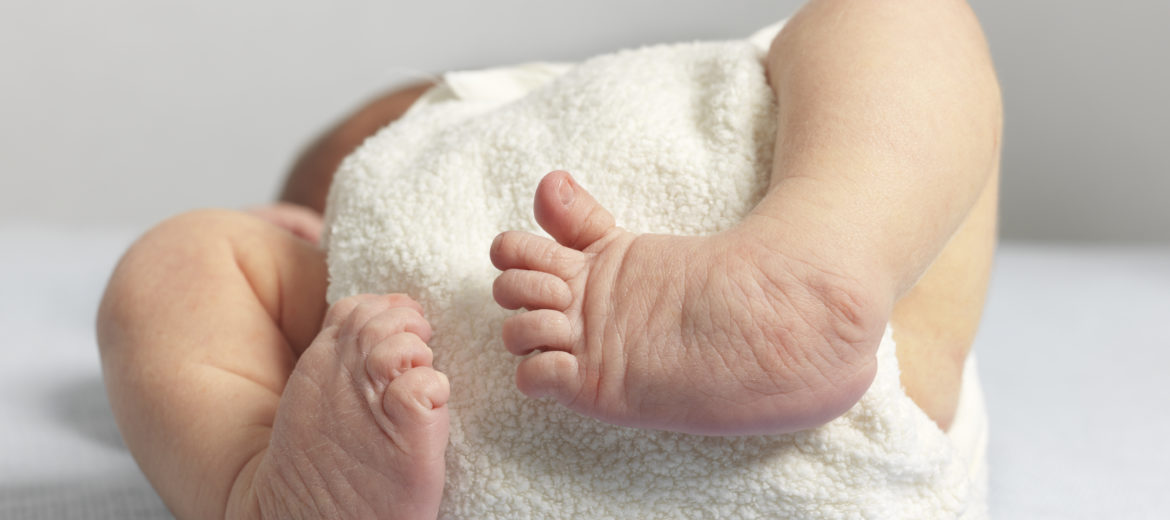At Raghav’s birth, the pediatrician at Sitaram Bhartia noticed his feet were abnormally bent, which caused the parents – Jyoti and Akash – to worry about their son’s health.
“This is where we heard about CTEV or clubfoot for the first time,” recalled Jyoti.
CTEV (Congenital Talipes Equinovarus), more commonly known as clubfoot, is a birth defect where an infant’s foot is twisted inward. This deformity, present at birth worsens over time if left untreated.
Upon further investigation by our pediatrician, Raghav was immediately referred to Dr. Gourav Jandial, Pediatric Orthopedic Surgeon at Sitaram Bhartia Hospital, Delhi.
“CTEV does not need to be a cause of panic if treated early,” reassured Dr. Gourav.
Jyoti posed some questions at the consultation before they decided to go ahead with the treatment –
How does clubfoot affect a child?
“CTEV or clubfoot isn’t painful for the babies. As your child grows, however, they can have difficulties in walking and the condition can become painful if clubfoot treatment is delayed.”
Don’t delay your child’s diagnosis any longer. Avail a second opinion from our consultants today and resolve all your doubts! Please call us on +91 8826391002 to schedule a consultation.
CTEV affects the ankle and foot and is diagnosed at birth. The leg looks deformed, visibly shorter than normal and the girth of the calf muscles also appears less.
Keep in mind that, in most cases, clubfoot can be detected during a prenatal ultrasound.
What causes clubfoot in a fetus?
“For most cases, clubfoot causes are not known (idiopathic in nature). There are some situations, however, where it tends to be seen more commonly.”
“In these cases, the defect may occur if spinal disorders such as meningomyelocele are present in the infant during birth.”
“Could Raghav’s condition have happened due to anything I did during or after pregnancy?” asked Jyoti, worried that she had caused her son harm.
Dr. Gourav was quick to quell her worries – “Though clubfoot causes are as of yet unknown, it is not related to how you have handled your pregnancy or the infant after birth.”
Can you treat CTEV?
Treatment for CTEV should be started as early as the 1st or 2nd week.
If diagnosed early and treated under expert guidance, children with clubfoot can grow up to have as close to normal feet as possible, to run and play like their peers.
Raghav’s CTEV treatment was begun with non-surgical methods like stretching, exercises, and serial plaster casting called the Ponseti method.
Sometimes, a minor surgical procedure (tenotomy) is required at the end of the casting regimen.
This minor surgery, tenotomy, loosens the muscle at the back of the ankle and corrects the foot’s position.
“In certain severe cases of clubfoot, there is a possible need for corrective surgery.”
After the possibility of surgery was mentioned, Jyoti and Akash seemed unsure.
“Is clubfoot surgery required for my child’s state?” asked the anxious couple.
“As the child is still young and growing, the tissues are more flexible,” answered Dr. Gourav.
“This means the shape of their feet can be corrected to near normal easily at this stage with serial casting and without any major foot reconstructive surgery.”
Jyoti and Akash decided to go ahead with the treatment as they realized further delay could worsen Raghav’s condition.
Dr. Gourav continued careful stretching and manipulation of the foot using a cast to treat Raghav. This was repeated every week over 6 weeks.
Conclusion
Most of the patients can be treated fully in the early months using the non-operative procedures mentioned above.
“Do keep in mind that once the foot is corrected, it needs to be maintained in certain shoes and splints (the maintenance phase) to reduce the risk of recurrence.”
A lot of parents tend to leave the treatment in the middle as clubfoot treatment/management involves a long maintenance phase (which involves brace/ shoes for a few years).
This ends up making the condition more resistant to treatment and would then require clubfoot surgery.
Raghav’s parents vowed to stay consistent with his treatment and met with Dr. Gourav as advised by him for follow-up consultations.
Raghav’s feet showed signs of improvement within a few weeks after initiation of treatment, and he was able to walk and run normally like his peers.
“For proper CTEV management, regular follow-ups and a lot of patience is a must. Consult your doctor as early as possible for the best clubfoot treatment,” emphasized Dr. Gourav.
This article was originally written in 2018 and has been updated for accuracy in 2021 with inputs from Dr. Gourav Jandial, Pediatric Orthopedic Surgeon at Sitaram Bhartia Institute of Science and Research, South Delhi.
 Medically Reviewed by Dr. Gourav Jandial
Medically Reviewed by Dr. Gourav Jandial
Qualifications: M.B.B.S, Govt. Medical College, Jammu, J&K (2009); P.G. Diploma in Orthopaedics, Govt. Medical College, Jammu, J&K (2013); D.N.B. in Orthopaedics, Indian Spinal Injuries Centre, New Delhi (2015); Fellowship Paediatric Orthopaedics, Chacha Nehru Bal Chikitsalaya, New Delhi (2018); Asian Travelling Fellowship – Paedriatric Orthopaedics, Shiga Medical Centre, Moriyama, Japan (2019)

